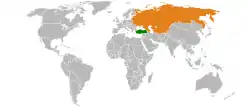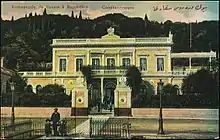Soviet Union–Turkey relations
Soviet Union–Turkey relations were the diplomatic relations between the Soviet Union and the Republic of Turkey.
 | |
Turkey |
Soviet Union |
|---|---|
Background
History
Early co-operation with Turkish revolutionaries
The Ottoman government signed the Treaty of Brest-Litovsk between the Bolshevik government of Russia and the Central Powers on March 3, 1918, but it became obsolete later that year. Russian Bolsheviks and the Soviet government were led by Vladimir Lenin, who emerged victorious from the Russian Civil War by 1921 and viewed the Turkish revolutionary (national) movement under the leadership of Mustafa Kemal as congenial to their ideological and geopolitical aspirations. Lenin's government abdicated the traditional claims of the Russian Empire to the territories of Western Armenia and the Turkish Straits.
The Soviet supply of gold and armaments to the Kemalists in 1920 to 1922 was a key factor in the latter's successful takeover of the Ottoman Empire, which had been defeated by the Triple Entente but won the Armenian campaign (1920) and the Greco-Turkish War (1919–1922).[1]

The Russian Soviet Federative Socialist Republic was the first state that formally recognised the Kemalist government of Turkey in March 1921 after the Republic of Armenia which signed the Treaty of Alexandropol with the Turkish revolutionaries on 2 December 1920. The Treaty of Moscow, signed on 16 March 1921 between Lenin's government and the Grand National Assembly of Turkey government (although the Sultanate was still nominally in existence), followed bilateral treaties that the Moscow government concluded with Persia and Afghanistan earlier that year (apart from those with the states on the territory of the former Russian Empire). On the same day, in London, Russia signed a trade agreement with the United Kingdom, which was hailed as "of principal consequence" by the Pravda newspaper.[2]
Treaties of trade and co-operation
Under the 1921 Treaty of Moscow,[3] the two governments undertook to establish friendly relations between the countries. Under Article II, Turkey ceded Batum and the adjacent area north of the village of Sarp to Soviet Georgia (Kars Oblast went to Turkey). Article III instituted an autonomous Nakhchivan oblast under Soviet Azerbaijan's protectorate. Article V had the parties agree to delegate the final elaboration of the status of the Black Sea and the Turkish Straits to a future conference of delegates of the littoral states if the "full sovereignty" and security of Turkey and "her capital city of Constantinople" were not injured. The Treaty of Moscow was followed by an identical Treaty of Kars signed in October 1921 by the Kemalists with Soviet Armenia, Soviet Azerbaijan and Soviet Georgia, which formed part of the Soviet Union after the December 1922 Treaty on the Creation of the Soviet Union.
The GNAT diplomatic note, dated October 24, 1922, demanded the Soviet government to terminate operations of its trade mission in Turkey until a trade agreement was signed,[4] which was concluded on March 11, 1927.[5]
On 16 December 1925, the Turkish government withdrew its delegation, which let the League of Nations Council grant a mandate for the disputed region of Mosul to Britain without its consent. Kemal countered the diplomatic reverse[6] by concluding a non-aggression pact[7] with the Soviet Union on 17 December. The pact was later amended and prolonged and then was prolonged again for another ten years on November 7, 1935.[8]
According to Georges Agabekov, a senior OGPU defector, Turkey was until 1930 viewed by the Soviet secret police and espionage agencies as a friendly power, but co-operation proposals on the part of the Turkish police and intelligence were declined.[9] In parallel to the fluctuating bilateral relations, the communist leaders, party functionaries, diplomats and scholars paid close attention to the origins, evolution and transformational phases of Kemalism.[10]
Growing tensions over territory
The first serious tensions in both countries' relations emerged during the negotiations that led to the signing of the Montreux Convention in July 1936 in which Turkey regained control over the Straits, which it was allowed to remilitarise.[11] Stalin's government believed that Turkey had "vacillated" and even "come out against the Soviet Union's legitimate and substantiated proposals".[12]
Turkey officially remained neutral during the Second World War until 23 February 1945, but the Soviet Union viewed Turkey's continued relationship with Nazi Germany, whose warships were allowed passage through the Straits,[13] as inimical to itself.[13]
On 19 March 1945, Soviet Foreign Minister Vyacheslav Molotov advised Turkey's ambassador in Moscow that the Soviet Union was unilaterally withdrawing from the 1925 Non-Aggression Pact.[14] The decision was explained by asserting that "because of the deep changes that had occurred especially during World War II", the treaty did not cohere with "the new situation and needed serious improvement".[15] When the Turkish government enquired on what conditions a new agreement could be concluded, it was informed by Molotov that in addition to bases in the Straits, the Soviets claimed part of eastern Turkey, which was assumed to refer to the districts of Kars, Artvin and Ardahan, which the Russian Empire and the short-lived DRA had held between 1878 and 1921.[16]
In his congratulatory message to Stalin dated May 16, 1945, Turkish Prime Minister Şükrü Saracoğlu called Stalin "the famous leader to whom I am personally committed". In response, he received a one-line message of terse acknowledgement.[17]
Turkey joins NATO
At the Potsdam Conference (July 1945), Stalin demanded a revision of the Montreux Convention. The British and the Americans agreed with the Soviet demand for the Straits always to be open to the warships of the Black Sea powers and, in principle, remain closed to those of outside powers. However, the Soviets also demanded to be allowed to join the defence of the Straits, which was rejected by Turkey, which was backed by the West.[16]
In March 1947, with the proclamation of the Truman Doctrine, the Americans underwrote the frontiers of Turkey and Greece and the continued existence of non-communist governments in both countries.[16]
The Turks sought aid from the Americans and joined NATO in 1952. The Soviets and the Turks were in different camps during the Korean War and throughout the Cold War.
References
- В. Шеремет. Босфор. Moscow, 1995, p. 241.
- Pravda. 20 March 1921, № 60, p. 1.
- Документы внешней политики СССР. Moscow, 1959, Vol. III, pp. 597-604.
- Документы вешней политики СССР. Moscow, 1961, Vol. V, pp. 635-636.
- Документы вешней политики СССР. Moscow, 1961, Vol. V, pp. 763.
- John P. Kinross. Atatürk: a biography of Mustafa Kemal, father of modern Turkey. New York, 1965, p. 464.
- Документы вешней политики СССР. Moscow, 1961, Vol. VIII, pp. 739-741 (text of treaty).
- Документы вешней политики СССР. Moscow, 1961, Vol. VIII, pp. 813.
- Агабеков. Г. П. У. Записки чекиста. Berlin, Strela, 1930, pp. 218-219.
- Vahram Ter-Matevosyan. "Turkey, Kemalism and the Soviet Union: Problems of Modernization, Ideology and Interpretation" London and New York, Palgrave Macmillan, 2019.
- Mango, Andrew. Turkey. Thames and Hudson, London, 1968, p. 63.
- БСЭ, 1st ed., Moscow, Vol. 55 (1947), col. 378 ff.
- БСЭ, 1st ed., Moscow, Vol. 55 (1947), col. 381.
- БСЭ, 1st ed., Moscow, Vol. 55, (1947), col. 382.
- Внешняя политка Советского Союза в период Отечественной войны. ОГИЗ, 1947, Vol. III, p. 146.
- Mango, Andrew. Turkey. Thames and Hudson, London, 1968, p. 69.
- Внешняя политка Советского Союза в период Отечественной войны. ОГИЗ, 1947, Vol. III, p. 545.
Further reading
- Gökay, Bülent. Soviet Eastern Policy & Turkey, 1920-1991: Soviet Foreign Policy, Turkey & Communism (2006), 184pp. excerpt
- Hale, William. Turkish foreign policy since 1774 (Routledge, 2012).
- Hashimoto, Chikara, and Egemen B. Bezci. "Do the Kurds have ‘no friends but the mountains’? Turkey's Secret War against Communists, Soviets and the Kurds." Middle Eastern Studies 52.4 (2016): 640-655.
- Hirst, Samuel J. "Transnational Anti-Imperialism and the National Forces Soviet Diplomacy and Turkey, 1920-23." Comparative Studies of South Asia, Africa and the Middle East 33.2 (2013): 214–226. online
- Hirst, Samuel J. “Anti-Westernism on the European Periphery: The Meaning of Soviet-Turkish Convergence in the 1930s.” Slavic Review 72 (2013): 32 – 53.
- Kapur, Harish. Soviet Russia and Asia 1917-1927: A Study of Soviet Policy towards Turkey, Iran and Afghanistan (Geneva Graduate Institute of International Studies, 1966).
- Kiniklioğlu, Suat, and Valeriy Morkva. "An anatomy of Turkish–Russian relations." Southeast European and Black Sea Studies 7.4 (2007): 533–553.
- Kuniholm, Bruce R. //The origins of the Cold War in the Near East: Great power conflict and diplomacy in Iran, Turkey, and Greece (Princeton UP, 2014).
- O’Connor, Timothy Edward. Diplomacy and Revolution: G. V. Chicherin and Soviet Foreign Affairs, 1918 – 1930. (Iowa State UP, 1988).
- Roberts, Geoffrey. "Moscow’s Cold War on the Periphery: Soviet Policy in Greece, Iran, and Turkey, 1943—8." Journal of Contemporary History 46.1 (2011): 58-81.
- Tamkin, Nicholas. Britain, Turkey and the Soviet Union, 1940-45: Strategy, Diplomacy and Intelligence in the Eastern Mediterranean (Springer, 2009).
- Ter-Matevosyan, Vahram. "Turkish transformation and the Soviet Union: navigating through the Soviet historiography on Kemalism." Middle Eastern Studies 53.2 (2017): 281-296. online[
- Ter-Matevosyan, Vahram. "Turkey, Kemalism and the Soviet Union: Problems of Modernization, Ideology and Interpretation" London & New York, Palgrave Macmillan, 2019.
- Zalyaev, Ramil. "The Soviet Attitude Towards Turkey in the First Years of their Relations, and the 1925 Neutrality Treaty." International Journal of Turkish Studies (2005) 11#1-2 pp 107–126. covers 1918 to 1925.
.svg.png.webp)